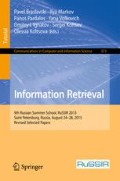Abstract
We present a novel approach to analyze and visualize opinion polarisation on Twitter based on graph features of communication networks extracted from tweets. We show that opinion polarisation can be legibly observed on unimodal projections of artificially created bimodal networks, where the most popular users in retweet and mention networks are considered nodes of the second mode. For this purpose, we select a subset of top users based on their PageRank values and assign them to be the second mode in our networks, thus called pseudo-bimodal. After projecting them onto the set of “bottom” users and vice versa, we get unimodal networks with more distinct clusters and visually coherent community separation. We developed our approach on a dataset gathered during the Russian protest meetings on 24th of December, 2011 and tested it on another dataset by Conover [13] used to analyze political polarisation, showing that our approach not only works well on our data but also improves the results from previous research on that phenomena.
Access this chapter
Tax calculation will be finalised at checkout
Purchases are for personal use only
Notes
- 1.
The term pseudo-bimodal networks is based on the previously introduced notion of pseudo-tricluster in two paired bimodal networks [16].
References
Adamic, L.A., Glance, N.: The political blogosphere and the 2004 U.S. election: divided they blog. In: Proceedings of the 3rd International Workshop on Link Discovery, LinkKDD 2005, pp. 36–43. ACM, New York, NY, USA (2005). http://doi.acm.org/10.1145/1134271.1134277
Aramaki, E., Maskawa, S., Morita, M.: Twitter catches the flu: detecting influenza epidemics using twitter. In: Proceedings of the Conference on Empirical Methods in Natural Language Processing, pp. 1568–1576. Association for Computational Linguistics (2011)
Bakshy, E., Hofman, J.M., Mason, W.A., Watts, D.J.: Everyone’s an influencer. In: Proceedings of the Fourth ACM International Conference on Web Search and Data Mining - WSDM 2011, p. 65. ACM Press, New York, New York, USA (2011). http://portal.acm.org/citation.cfm?doid=1935826.1935845
Bennett, W.L., Johnson, C.N.: A model of crowd-enabled organization: theory and methods for understanding the role of Twitter in the occupy protests. Int. J. Commun. 8, 646–672 (2014)
Blondel, V.D., Guillaume, J.L., Lambiotte, R., Lefebvre, E.: Fast unfolding of communities in large networks. J. Stat. Mech.: Theory Exp. 2008(10), P10008 (2008)
Bollen, J., Mao, H., Zeng, X.J.: Twitter mood predicts the stock market (2010). arXiv preprint arxiv:1010.3003
Bruns, A., Highfield, T., Burgess, J.: The Arab spring and social media audiences: English and Arabic Twitter users and their networks. Am. Behav. Sci. 57(7), 871–898 (2013). http://abs.sagepub.com/cgi/doi/10.1177/0002764213479374
Bruns, A., Burgess, J.E.: The use of Twitter hashtags in the formation of ad hoc publics. In: 6th European Consortium for Political Research General Conference (2011)
Bruns, A., Highfield, T.: Political networks on Twitter. Inf. Commun. Soc. 16(5), 667–691 (2013). http://www.tandfonline.com/doi/abs/10.1080/1369118X.2013.782328
Bulearca, M., Bulearca, S.: Twitter: a viable marketing tool for SMEs. Glob. Bus. Manag. Res.: Int. J. 2(4), 296–309 (2010)
Cha, M., Haddai, H., Benevenuto, F., Gummadi, K.P.: Measuring user influence in Twitter: the million follower fallacy. In: International AAAI Conference on Weblogs and Social Media (2010)
Comunello, F., Anzera, G.: Will the revolution be tweeted? A conceptual framework for understanding the social media and the Arab Spring. Islam Christ. Muslim Relat. 23(4), 453–470 (2012). http://www.tandfonline.com/doi/abs/10.1080/09596410.2012.712435
Conover, M., Ratkiewicz, J., Francisco, M., Gonalves, B., Menczer, F., Flammini, A.: Political polarization on Twitter. In: ICWSM (2011). http://www.aaai.org/ocs/index.php/ICWSM/ICWSM11/paper/viewFile/2847
Coppersmith, G., Dredze, M., Harman, C.: Quantifying mental health signals in Twitter. In: Proceedings of ACL Workshop on Computational Linguistics and Clinical Psychology, Association for Computational Linguistics (2014)
Gayo-Avello, D.: A meta-analysis of state-of-the-art electoral prediction from Twitter data. Soc. Sci. Comput. Rev. 31(6), 649–679 (2013). http://ssc.sagepub.com/cgi/doi/10.1177/0894439313493979
Gnatyshak, D., Ignatov, D.I., Semenov, A., Poelmans, J.: Gaining insight in social networks with biclustering and triclustering. In: Aseeva, N., Babkin, E., Kozyrev, O. (eds.) BIR 2012. LNBIP, vol. 128, pp. 162–171. Springer, Heidelberg (2012)
Golbeck, J., Hansen, D.: A method for computing political preference among Twitter followers. Soc. Netw. 36, 177–184 (2014). http://linkinghub.elsevier.com/retrieve/pii/S0378873313000683
Gonzalez-Bailon, S., Borge-Holthoefer, J., Moreno, Y.: Broadcasters and hidden influentials in online protest diffusion. Am. Behav. Sci. 57(7), 943–965 (2013). http://abs.sagepub.com/cgi/doi/10.1177/0002764213479371
González-Bailón, S., Borge-Holthoefer, J., Rivero, A., Moreno, Y.: The dynamics of protest recruitment through an online network. Sci. Rep. 1, 197 (2011). http://www.pubmedcentral.nih.gov/articlerender.fcgi?artid=3240992&tool=pmcentrez&rendertype=abstract
Highfield, T.: Mapping intermedia news flows: topical discussions in the Australian and French political blogospheres. Ph.D. thesis, Queensland University of Technology (2011)
Newman, M.E.J.: Scientific collaboration networks. II. Shortest paths, weighted networks, and centrality. Phys. Rev. E 64(1), 016132 (2001)
Nikiporets-Takigawa, G.: Tweeting the Russian protests. Digital Icons: Stud. Russ. Eurasioan Cent. Eur. New Media 9(2013), 1–25 (2013)
Page, L., Brin, S., Rajeev, M., Terry, W.: The pagerank citation ranking: bringing order to the web. Technical report, Stanford University (1998)
Vieweg, S., Hughes, A.L., Starbird, K., Palen, L.: Microblogging during two natural hazards events: what twitter may contribute to situational awareness. In: Proceedings of the SIGCHI Conference on Human Factors in Computing Systems, pp. 1079–1088. ACM (2010)
Yardi, S., Boyd, D.: Dynamic debates: an analysis of group polarization over time on Twitter. Bull. Sci. Technol. Soc. 30(5), 316–327 (2010). http://bst.sagepub.com/cgi/doi/10.1177/0270467610380011
Acknowledgements
This paper was prepared within the framework of a subsidy granted to HSE by the Government of Russian Federation for implementation of the Global Competitiveness Program. The work of Sergey Nikolenko was supported by the Russian Science Foundation grant no. 15-11-10019.
Author information
Authors and Affiliations
Corresponding author
Editor information
Editors and Affiliations
Rights and permissions
Copyright information
© 2016 Springer International Publishing Switzerland
About this chapter
Cite this chapter
Zakhlebin, I., Semenov, A., Tolmach, A., Nikolenko, S. (2016). Detecting Opinion Polarisation on Twitter by Constructing Pseudo-Bimodal Networks of Mentions and Retweets. In: Braslavski, P., et al. Information Retrieval. RuSSIR 2015. Communications in Computer and Information Science, vol 573. Springer, Cham. https://doi.org/10.1007/978-3-319-41718-9_10
Download citation
DOI: https://doi.org/10.1007/978-3-319-41718-9_10
Published:
Publisher Name: Springer, Cham
Print ISBN: 978-3-319-41717-2
Online ISBN: 978-3-319-41718-9
eBook Packages: Computer ScienceComputer Science (R0)

